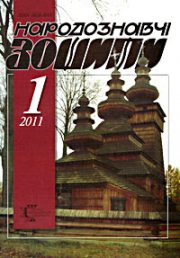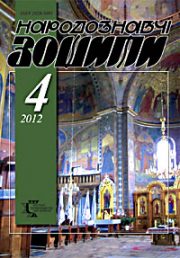The Ethnology Notebooks. 2022. № 6 (168), 1247—1254
UDK 930.2:[271/.272-565:398.332.416](=1:477:438-192.2)
DOI https://doi.org/10.15407/nz2022.06.1247
RELIGIOUS CELEBRATION AS A FORM OF ETHNIC INTERCOMMUNICATION AT THE UKRAINIAN-POLISH BORDER
CHMELYK Roman
- ORCID ID: https://orcid.org/0000-0003-4052-029X
- Doctor of Historical Sciences, senior researcher,
- Director, Lviv Historical Museum,
- 6, Rynok Sq., 79000, Lviv, Ukraine,
- Contacts: e-mail: rchmelyk@gmail.com
Abstract. Ukrainian-Polish border as a place of everyday interethnic communication is a rich field for ethnological research, especially such scientific problem as the role of religiousness in the shaping of local identities.
The purpose of this article is to analyze the practices of celebration of such religious holidays as Christmas and Easter by Ukrainians (Greek Catholic, Orthodox) and Poles (Roman Catholic) as factors of interethnic discourse and traditional forms of coexistence in communities.
The source base of this publication is comprised of rich source material collected during ethnological expeditions in the Ukrainian-Polish border in 2006—2013.
Territorial scope of this research encompasses borderline areas of Lviv and Volyn Oblasts of Ukraine, as well as Subcarpathian and Lublin Voivodeships of the Republic of Poland.
Field survey material collected on the Ukrainian-Polish borderlands fully covers the object and subject of this research.
Methodological principles of systematic analysis and structural-contextological approach to analyzing filed material made it possible to substantiate the premise of common traditions of religious celebration being the result of functioning of a new kind of frontier: an open-end dynamic environment.
Shared celebration of religious holidays and respect for traditions of neighbors from other religious denomination became the result of continuous experience of interethnic communications conveyed through intermarriage, neighborly amicability, and long-term professional relationships.
Keywords: border, Ukrainians, Poles, religious celebration, interethnic communication.
Received 13.04.2022
REFERENCES
- Napiorkowski, M., Saryusz-Wolska, M., & Traba, R. (Eds.). (2014). Myth. Modi memorandi. Lexicon of the culture of remembrance (Pp. 237—240). Warszawa: Wydawnictwo Naukowe Scholar [in Polish].
- Obirek, S., & Saryusz-Wolska, M., & Traba, R. (Eds.). Sacrum. (2014). Modi memorandi. Leksykon kultury pamieci. Modi memorandi. Lexicon of the culture of remembrance (Pp. 452—453). Warszawa: Wydawnictwo Naukowe Scholar [in Polish].
- Assmann, J. (2006). Religion and Cultural Memory. Stanford: Stanford University Press.
- Smyrski, L., & Zowczak, M. (Eds.). (2003). At the beginning there was Kain — visions of Ukrainian history in the context of the theory of ethnicity. Podole and Woіyс: ethnographic notes (Pp. 311—322).Warszawa: DiG [in Polish].
- Terner, F. (2011). The importance of the Frontier in American history. Ukraina moderna: borders, outskirts, peripheries (Issue 18, pp. 11—46). Lviv [in Ukrainian].
- Archive of the IN NANU. F. 1. Op. 2. Od. save 703 [in Ukrainian].
- Vyzdryk, V. (2015). Galician village: socio-economic life and socio-political processes (1919—1939). Lviv: Instytut ukrainoznavstva im. I. Krypiakevycha NAN Ukrainy [in Ukrainian].
- Davydiuk, R. (2016). Ukrainian political emigration in Poland: composition, structure, socio-political practices in the territory of Volyn Voivodeship. Lviv; Rivne: M. Diatlyk [in Ukrainian].
- Archive of the IN NANU. F. 1. Op. 2. Od. save 623 [in Ukrainian].
- Archive of the IN NANU. F. 1. Op. 2. Od. save 664 [in Ukrainian].
- Posern-Zielinski, A. (2005). Ethnicity: categories, ethnic processes. Poznan: Poznanskie Towarzystwo Przyjacol Nauk [in Polish].
- Archive of the IN NANU. F. 1. Op. 2. Od. save 622 [in Ukrainian].
- Dudek, A., & Czyzewski, F. (Ed.). (2003). Annual rites and customs of the Wola Uhruska commune. The commune of Wola Uhruska in the Euroregion Bug: language and culture (Pp. 137—151). Wola Uhruska: Urzad Gminy [in Polish].
- Demskyi, D. (2007). Borders as a patchwork: reflections from Belarus. Narodna tvorchist ta etnohrafiia, 1, 80—91 [in Ukrainian].
- Archive of the IN NANU. F. 1. Op. 2. Od. save 621 [in Ukrainian].
- Archive of the IN NANU. F. 1. Op. 2. Od. save 584 [in Ukrainian].
- Kappeler, A. (2011). «Over the border»: the concept of border as an object of study. Ukraina moderna: borders, outskirts, peripheries (Issue 18, pp. 48—53). Lviv [in Ukrainian].
- Grigor’eva, R., Kasperovich, G., & Martynova, M. (Eds.). (2005). Identity and demographic characteristics of the population. Belarusian-Russian borderlands: an ethnological study (Pp. 37—84). Moskva: RUDN [in Russian].
- Drozd, R. (1999). The main purpose of the «Vistula» Action. «Vistula» Action in the Context of Ukrainian-Polish Relations of the 20th Century: Proceedings of the Scientific Conference Dedicated to the 50th Anniversary of the Vistula «Action» (Pp. 43—48). Ivano-Frankivsk [in Ukrainian].
- Kyrchiv, R. (2012). Field notes and materials on ethnocultural crossroads. In Narodoznavchi zoshyty, 2, 227—240 [in Ukrainian].







